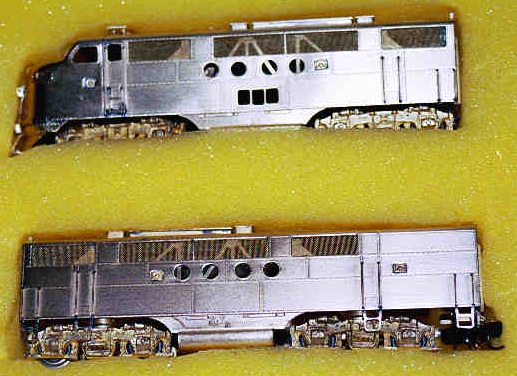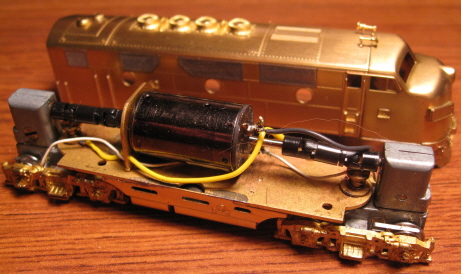| F3A & F3B (Phase 1) | F7A & F7B |
 | |
| F9A & F9B | FTA & FTB |
 |  |
| F3A & F3B (Phase 1) | F7A & F7B |
 | |
| F9A & F9B | FTA & FTB |
 |  |
Introduced: 1983 (first version) and 1995 (second version)
These models (F3, F7, F9 and FT) all share the same history and sport one of two basic mechanism designs. So, in order to save myself a bit of time (and money), I'm going to review them all here based on the couple of examples I've actually purchased and tested.
First off, yes, they're gorgeous. I particularly like the separately applied handgrabs and the see-through vent screens. Better still, they are (for the most part) surprisingly nice running models (especially given their age). Mine have great pick-up (no traction tires to get in the way), excellent throttle response and amazing slow-speed performance (although the top-end on the second version is excessive). All wheels are geared and provide pickup.
As noted above, there were two different production runs of these models (and with the second version sporting a completely redesigned mechanism) -

The first version is a fairly standard Samhongsa mechanism with swiveling truck towers, etc. The newer version jettisoned the truck towers and added weights, flywheels, a new 5-pole motor, and completely redesigned trucks. It's my understanding that only F3 and F7 sets were manufactured in this second run (FTs and F9s having been excluded).
The second-run mechanism was actually inspired by a Kato design, and as such, is subject to some of the same problems. Namely, if any of the various drivetrain pieces get even slightly out of alignment, the thing will go all "electric razor" on you. The first run mechanism, though less sophisticated, does not have these noise problems.
According to Gene Maddox (former Hallmark Models/Hall's Hobby Shop employee) Hallmark sent a Kato locomotive mechanism to Samhongsa and asked them to use it as their guide for designing the new mechanism. Consequently, the second-run version wound up looking very much like a 1990s Kato. The trucks on the second run had plastic sideframes and nylon gears. To remove the trucks, you simply twist them 90 degrees. These trucks will almost interchange with Kato trucks, but not quite. The motor has two flywheel/worm gear assemblies attached to it. Said assemblies have two large weights sitting atop them. The motor itself is a strong-running 5-poler. Appararently the biggest problem they had with this mechanism (apart from the noise issue) was the occasionally iffy contact between the trucks and the chassis. This could be addressed by twisting off the trucks and cleaning the contact points between the chassis and the trucks (oil would tend to collect there).
And from the "Department Of Muddying The Waters", we have this set that showed up on eBay -

As you can see, the mechanism in the A unit is rather different from the one in the B unit. And at this point I'm not sure if this was some sort of later/redesigned release or something that somebody somewhere cooked up on their own. However, the lack of weights (which would be a very bad idea) leads me to believe that it's probably somebody's one-off try at addressing the noise issue.
As things stand, I can't quite give either version an "A". Both runs lack window glazing and lighting, the first-run has primitive wheel wipers (and miles of current-conducting wire), and the second-run has those aforementioned noise issues. Still and all, both releases are smooth and reliable runners (not to mention gorgeous), so definitely up there in the "B" category.


First and second run models are easily identified by their trucks. The first release is fairly typical Samhongsa stuff, what with their "remove the screws and watch the trucks fall apart into a million little metal pieces" design. The newer version actually makes use of a one piece plastic base/sideframe assembly that snaps in place.
Samhongsa (bless 'em) provides a nifty little packet of spare parts - replacement gears, screws and winterization hatches. First run undecorated sets come with their little step ladder extensions similarly uninstalled. And I can see why. Once installed, they sit uncomfortably close to those metal truck sideframes. And as a consequence, they can actually come into contact with said sideframes on narrow radius curves (causing the motor to short circuit).
A permanant drawbar is provided for the A/B connection. Installation of Micro-Trains style couplers on the front of the A and the back of the B looks to be a pretty straightforward operation (as delivered, there are no couplers).
Only first run FT sets were available with dummy B units. And this was actually a mistake on Samhongsa's part. When Hallmark ordered these models, they'd assumed that all sets would contain powered A/B pairs. However, when the first models showed up (the FTs), Hallmark was muchly shocked when they discovered that all of the B units were dummies. More importantly, customers were up in arms over the whole deal. So, Hallmark ordered up 150 powered chasses and offered them to customers who wanted to power their B units (not an easy swap either - some modifications to the shell were required).
Removing the shells is pretty simple - on the second run, just remove the four screws holding the shell to the chassis (one on each corner). The first run is a bit more challenging as the four screws are tucked away underneath the trucks (ugh).
Grade: B
Other variations -
F3A & F3B (PRR, Phase 2)


F3A & F3B (Phase 4)
